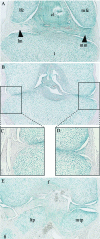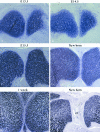Col2a1 lineage tracing reveals that the meniscus of the knee joint has a complex cellular origin
- PMID: 19014360
- PMCID: PMC2667547
- DOI: 10.1111/j.1469-7580.2008.00966.x
Col2a1 lineage tracing reveals that the meniscus of the knee joint has a complex cellular origin
Abstract
The knee joint consists of multiple interacting tissues that are prone to injury- and disease-related degeneration. Although much is known about the structure and function of the knee's constituent tissues, relatively little is known about their cellular origin and the mechanisms governing their segregation. To investigate the origin and segregation of knee tissues in vivo we performed lineage tracing using a Col2a1-Cre/R26R mouse model system and compared the data obtained with actual Col2a1 expression. These studies demonstrated that at E13.5 the interzone at the presumptive joint site forms when cells within the Col2a1-expressing anlagen cease expression of Col2a1 and not through cellular invasion into the anlagen. Later in development these interzone cells form the cruciate ligament and inner medial meniscus of the knee. At E14.5, after interzone formation, cells that had never expressed Col2a1 appeared in the joint and formed the lateral meniscus. Furthermore, cells with a Col2a1-positive expression history combined with the negative cells to form the medial meniscus. The invading cells started to express Col2a1 1 week after birth, resulting in all cells within the meniscus synthesizing collagen II. These findings support a model of knee development in which cells present in the original anlagen combine with invading cells in the formation of this complex joint.
Figures






References
-
- Archer CW, Dowthwaite GP, Francis-West P. Development of synovial joints. Birth Defects Res C Embryo Today. 2003;69:144–155. - PubMed
-
- Craig FM, Bentley G, Archer CW. The spatial and temporal pattern of collagens I and II and keratan sulphate in the developing chick metatarsophalangeal joint. Development. 1987;99:383–391. - PubMed
-
- Duthon VB, Barea C, Abrassart S, Fasel JH, Fritschy D, Menetrey J. Anatomy of the anterior cruciate ligament. Knee Surg Sports Traumatol Arthrosc. 2006;14:204–213. - PubMed
-
- Francis-West PH, Abdelfattah A, Chen P, et al. Mechanisms of GDF-5 action during skeletal development. Development. 1999;126:1305–1315. - PubMed
-
- Frank CB. Ligament structure, physiology and function. J Musculoskelet Neuronal Interact. 2004;4:199–201. - PubMed
Publication types
MeSH terms
Substances
Grants and funding
LinkOut - more resources
Full Text Sources
Molecular Biology Databases

